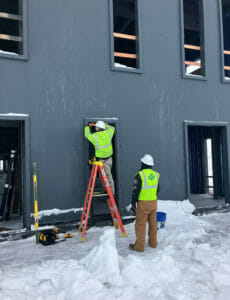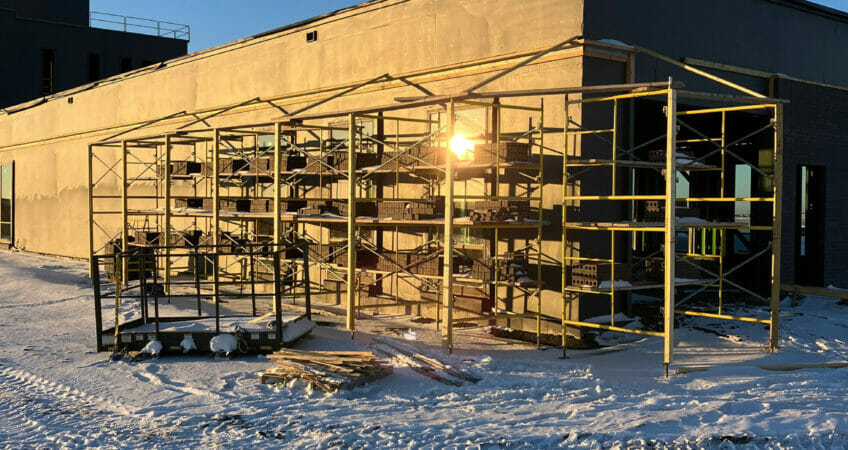How do you overcome winter construction challenges? One of the most common questions we get asked is, can construction work continue in winter. It’s a valid question; especially when you live in an area like ours where the months below freezing can sometimes outnumber the months above freezing! The good news is yes! Yes, we can continue construction progress in winter, with a few considerations.
Winter Construction Challenges
There are a few big winter construction challenges that we consider when planning a project. The first is low temperatures, the second is a frozen ground and the third is a slower pace of work. Some things we can work around, and others are just a part of working in the cold.
1. Low Temperatures
While we’re hardy folks up here in da nort, not all products and equipment can take the bitter cold. For example, concrete. While some concrete varieties give a little leeway to install in lower temps- and we can tarp and heat the poured area to help it cure properly- concrete below about 10-degrees runs the risk of freezing in the mixer tank. You can imagine the cleanup. Most concrete vendors avoid this scenario by halting concrete deliveries altogether if the temperatures drop below freezing. Due to this, we plan ahead to pour concrete in the warmer months.

2. Frozen Ground
Another challenge of working in the winter months is a frozen ground. Earthwork (digging, backfilling) is incredibly difficult to accomplish when the ground is frozen. It takes special attachments for your equipment and sometimes even warming the ground for any dirt to budge. Completion before the ground freezes is essential to avoid this hassle.
3. Slower Pace
Anyone who has lived here for a few seasons understands that life moves a little slower in the wintertime. It’s no different on the jobsite. Worksites need to be cleared of snow just like everywhere else. Safety considerations like warm gloves are needed but they restrict finer movements and slow the pace of work. Workers need to take more frequent breaks to warm up in heated trailers to protect themselves from frostbite. Even the products themselves take longer to set while installing in lower temps. A slower pace is just a fact of life in the north during the colder months and something we anticipate when budgeting for a project.
Workarounds in Wintertime Construction
While concrete and earthwork are best left to the warmer months, there are a few workarounds to keep a project moving in wintertime. Like the saying goes, if there’s a will, there’s always a way! It might be harder and more time consuming, but there’s always a way.
Trapping in Heat
One of the ways we continue working in the winter is to use tarps and heaters to trap heat in localized areas. In the construction industry it’s called “heat and shelter.” It’s cushier for workers, plus it allows us to work with materials that require above-freezing temps. Brickwork for example requires mortar to be at minimum of 40-degrees to set properly. Heating and sheltering the work area keeps the masons busy all winter long.
Swapping for Cold-Rated Materials
Another way we can keep labor hours up on a project is to swap materials with a colder-rated version. For example, the modern commercial construction industry typically uses spray-on protective barrier. The problem is that method doesn’t work unless the ambient temperature is at least 25-degrees. Our workaround is to use the old-fashioned rolled versions that you wrap around a surface versus spray. Using alternative products helps keep projects rolling.
Planning Ahead of Winter Construction Challenges
Planning a project takes skill, patience, and lots of coordination, even more so when working through winter construction months. When projects are anticipated to run through winter months, we look ahead to ensure the essentials like earthwork and concrete are completed ahead of freezing temps. We anticipate winter work and order cold-rated materials to continue progress. We also understand that during the colder months each task takes much longer to complete. About twice the time. So, we anticipate this in our scheduling. Winter is a fact of life in our part of the country but with careful planning we can continue working in winter to keep projects on track.


